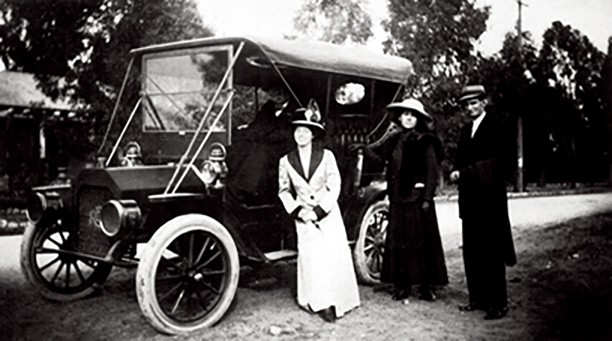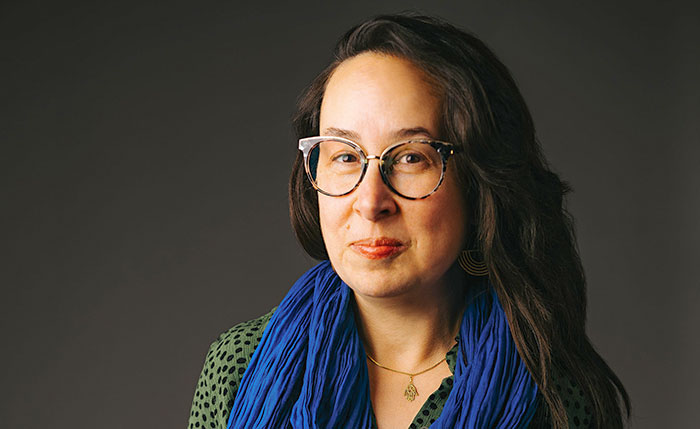Claremont Chamber of Commerce celebrates 100 years – Part 2

Ackerman family car: Leila Ackerman left, along with her siblings, Arthur and Martha, in front of their house on 10th Street.
by John Neiuber
Leila Ackerman assumed the position of secretary, what today would be the executive director, of the Claremont Chamber in 1923 and would serve in that capacity for the next 21 years, retiring in 1944. Ackerman was a tireless promoter of not only local businesses and merchants, the Colleges and the citrus industry, but the city itself and civic issues. Below the letterhead on chamber correspondence was a summation of the chamber mission, “A Community Clearing House for Business and Civic Improvement and Information.”
Under Leila Ackerman’s leadership, the chamber joined the “City Beautiful” movement in the 1920s. Teaming with renowned landscape architect, Ralph Cornell, the chamber hired him to create the landscape for the new civic center the chamber had helped to design. The chamber also “loaned out” Cornell to homeowners free of charge for the planning of their landscape.
The chamber worked with the city to develop the plans for the civic center and the newly appointed planning commission’s first order of business was to finalize those plans. The first part of the new civic center would be on Second Street and would include a first floor fire and police station and second floor city hall. The land was purchased in 1923, the bond issue passed in April 1924, construction began in June 1925, and the building opened on November 30, 1925.

The 1932 Claremont display at the L.A. County Fair designed by Leila Ackerman.
Given the close relationship between the chamber and the city, the Claremont Chamber of Commerce building was constructed on the northwest corner of Second Street and Harvard Avenue in 1930. The building was part of the civic center plan created by David Allison and Charles Cheney in the mid-1920s. In 1948, city hall was built around the chamber and the posts of the old building were changed to arches to complement the new design. This building was home to the chamber until 1975, when city hall was remodeled and the building was occupied by the city manager’s offices. The chamber moved into the police offices on Second Street when the police station was completed on Bonita Avenue. The chamber remained in the offices until the mid-1990s, when the expansion and renovation of city hall caused the chamber to relocate.
In the early years, the chamber was involved in many projects for the betterment of the community. The chamber was able to secure systematic garbage collection and took the lead in promoting a bond issue to pay for street paving. It also became involved in flood control issues, meeting and corresponding with the Los Angeles County Flood Control District. The chamber worked with the U.S. Postal Service to establish a post office and expand mail delivery throughout the city. The chamber led the way in initial zoning efforts and standards for residential and commercial construction and spearheaded the development of the city sewage system. It supported the construction of the library and the establishment of parks.
The early Fourth of July and Christmas programs were sponsored by the chamber. Before government agencies were responsible for such things, the distribution of items to families in need throughout the year, including special gift baskets at Thanksgiving and Christmas, were accomplished by the chamber. The chamber also served as an employment agency for both workers and employers, worked closely with the Red Cross and operated as a general welfare center, coordinating the work of all the local agencies through its Claremont Welfare Council.
The chamber also served as the location for the unemployed to register, which became a major function during the Depression. The Depression did not hit Claremont hard until 1933 and the chamber not only promoted local businesses but advocated for local workers as well. At the urging of the Mexican American community during the Depression, the chamber advocated for the packing houses to hire Claremont residents rather than bringing in laborers from outside. During the 1920s the chamber had also urged local businesses to hire Mexican American workers from within the community. The chamber spearheaded the efforts to help the unemployed and homeless living in the Claremont transient camp by providing food, clothing and other necessities.

The 1932 display at the L.A. County Fair took fourth place.
In a brief promotional history of Claremont that Ackerman penned in 1929, she noted that “Hand in hand with the development of the city and the college has been the development of the great citrus industry.” In 1923, at her urging, the chamber voted to join the Los Angeles County Fair Association. Over the next several years, the chamber in conjunction with the assistance of the city and Pomona College would construct displays at the fair to promote Claremont. Ackerman was usually the designer of the displays which earned awards year after year.
In the 1930s, the chamber conducted a survey of residents to prioritize its advocacy efforts. Four categories, public improvement projects, special projects, restrictions and regulations, and your further suggestions. Many favored the widening of Yale Avenue and adding more streetlights, stop signs and pedestrian zones. Parks and the addition of a swimming pool were also favored along with limited Sunday mail and telegram distribution. The formation of a central welfare committee was supported. Respondents also wanted owners to take care of vacant lots, regulations for dog vaccinations and licenses, limits on livestock in residential areas, and the railroad to limit train whistling.

College Heights: The citrus industry was a major driving force of the Claremont
economy from the 1890s through the 1950s.
As time passed, organizations such as the chamber, gradually reduced their overall community outreach as local, county, state and federal agencies took over functions. The city assumed the responsibilities for things such as roads, city trees, sewage system, zoning, building codes and refuse collection. The county developed the library system, flood control and social services. The state developed the highway system, the water delivery system and, along with the county and federal government, managed flood control. Today, the Claremont Chamber, like most local chambers are more involved in local and regional business issues, although the chamber provides input on county, state and federal legislation and regulations affecting businesses and employees.
To be continued.










0 Comments